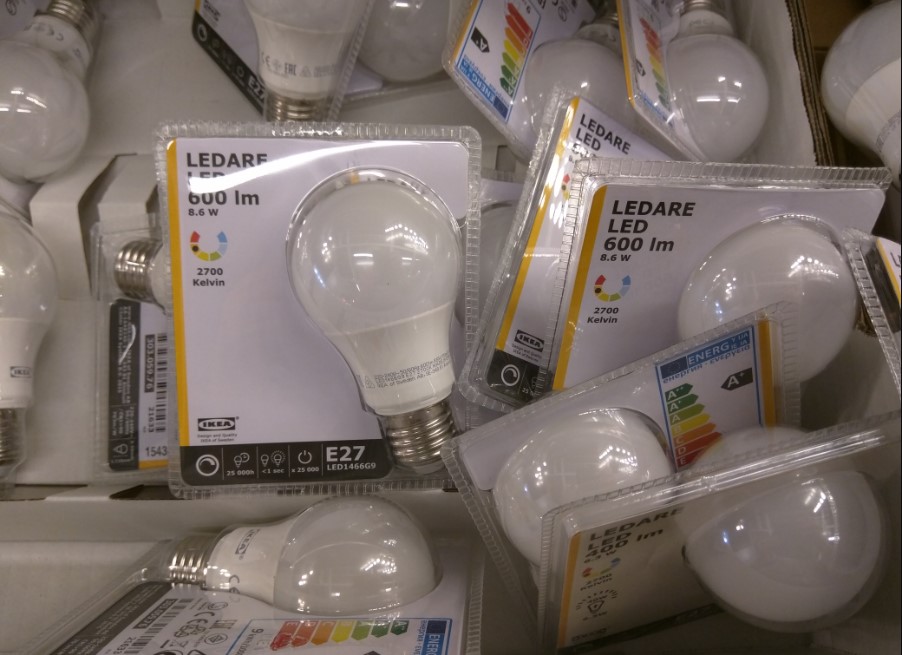- cross-posted to:
- news@lemmy.world
- green@lemmy.ml
- cross-posted to:
- news@lemmy.world
- green@lemmy.ml
Incandescent light bulbs are officially banned in the U.S.::America’s ban on incandescent light bulbs, 16 years in the making, is finally a reality. Well, mostly.



Wrap it up boys, we’ve solved climate change.
The EU introduced a limitation to how much power electric devices can consume in off or standby mode.
0.5 watt normally, 1 watt if they have a status display and 2-8 watts if they’re connected to a network.
On a yearly basis this saves as much electricity as one of the member states (Romania) used in a year.
My point is that small things add up to huge numbers.
LED bulbs aren’t really even a small thing.
going from a 100W bulb to a 15W bulb, or a 60W bulb to a 2.5W bulb (that’s the actual conversion for the bulbs i’ve actually bought on amazon and am currently using, not hypothetical guesses) across 20-30 bulbs in a single house is a real actual big difference in energy savings.
Exactly. From this particular article/policy:
Now instead of throwing out a little glass and wire, I get to throw out entire light fixtures with non-replacable LEDs soldered onto cheap PCBs that fail in about the same time as an incandescent light bulb!
I’m all for the energy efficiency of LEDs, but the cheap light fixtures replacing bulbs are a bad trend that needs to die, but they’re easier to wire and last longer on paper, so they’re getting installed everywhere by default.
So don’t buy non-replaceable fixtures?
How is removing incandescent bulbs from the marketplace going to increase the installation of fixtures with non-replaceable components, when such fixtures never used incandescent bulbs in the first place?
It can be difficult. I started asking around about getting recessed lighting installed in my kitchen and they all wanted to install disk lights.
These seem even worse since not only do you have to replace the fixture when it burns out, but you risk having to replace all the fixtures when it varies by color temperature or trim
They should charge you less for using cheaper material, reduce labor costs etc and charge the regular rate (like they fucking die before) to install a recessed fixture.
Overall, capitalism and rampant, irresponsible consumerism is to blame for all these quick fix solutions and lack of repairable devices. There is not one person to blame but ourselves for continuing to buy into this bs (literally)
For what it’s worth I’ve had one of those integrated overhead fixtures in my kitchen for about 6 years. It hasn’t failed yet. The overall shape of the fixture which we like also wouldn’t be possible if the bulbs were replaceable.
The light fixture in my apartment started flickering and not turning on all the way, and it was only a few years old (On a dimmer switch, the dimmer-compatible driver in the fixture died). I couldn’t even fix it myself because it’s hardwired and my landlord wouldn’t be happy with me playing electrician. So I was stuck with no light in that room for weeks until the landlord got it replaced.
Not to mention I couldn’t change the color temperature to match the rest of my lights, which drove me nuts.
They’re not all bad, there are many bad ones though and the light bulb form factor is better for repairability (but there are bad LED bulbs too).
OK, and? LEDs typically last way longer than 6 years, but it’s still going to be a pain to replace when it does fail.
Your sample size of one is useless
Well actually I’ve got one in my laundry room too and that one hasn’t failed either so it’s really a sample size of two. But either way if you don’t like it that’s why I said for what it’s worth.
Still useless
This has everything to do with implementation and complications from late-stage capitalism and not the actual technology
Im going to replace a two year old light because of this non replaceable light crap.